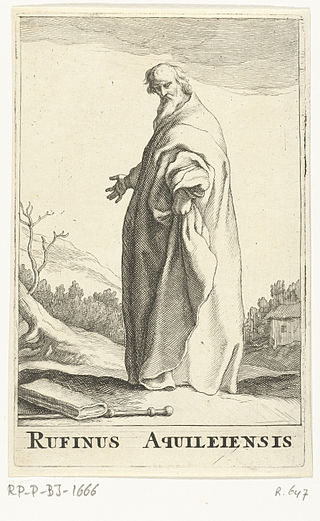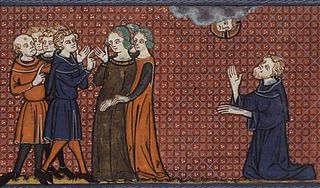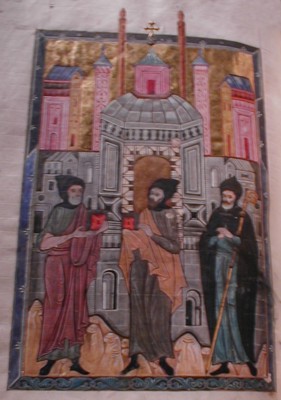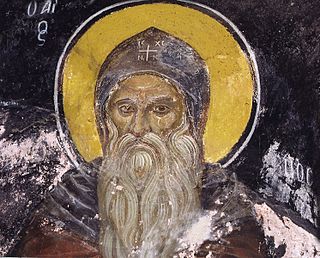
The Vitae Patrum or Vitas Patrum (literally Lives of the Fathers) is a collection of hagiographical writings on the Desert Fathers and Desert Mothers of early Christianity.

The Vitae Patrum or Vitas Patrum (literally Lives of the Fathers) is a collection of hagiographical writings on the Desert Fathers and Desert Mothers of early Christianity.
The earliest works that came to be part of the Vitae Patrum were composed in the 4th century, mostly in Greek. Between the 4th and 7th centuries, they were translated into Latin and the collections came to be known as Vitae Patrum. Which works were included under this title varied considerably, and Monika Studer refers to the Vitae as "a variable corpus of narratives". [1]
The original collection was just a group of the three biographies of desert monks by Jerome. [2] The biographies of Paul of Thebes, Hilarion and Malchus of Syria were originally composed in Latin between 370 and 390. [1]
Jerome's biographies belong to the legends or vitae proper, one of three types of work found in the collection. [1] The other types are:
Das Väterbuch is partially a German translation from around 1280.
An Italian vernacular translation was made by Dominican friar Domenico Cavalca from Pisa at the beginning of the fourteenth century.
A printed edition, edited by the Jesuit Heribert Rosweyde, was printed by Balthazar Moret in 1615. The book is a significant part of the much broader work, Acta Sanctorum . [3]
The Vitae Patrum is based on extensive research by Rosweyde into all the available literature he could find on the early desert monastics. Hippolyte Delehaye described the work as "the epic of the origins of monasticism in Egypt and Syria, an epic unsurpassed in interest and grandeur." In the thirteenth century, a version of Vitae Patrum had been translated into Latin. It was such a popular book that numerous versions and editions were published, with extensive changes and variations in the stories. Rosweyde based his book on twenty-three different versions of those earlier books, studying, dating, and classifying all the different versions and changes. [3]
Rosweyde's Vitae Patrum consists of ten books. Book I has the lives of sixteen saints under the title Vitae virorum and eleven saints under the title Vitae mulierum, beginning with St. Paul the Hermit and St. Anthony of the Desert, and including women saints such as Saint Mary the Harlot. Books II, Historia monachorum, and III, Verba seniorum (Sayings of the Elders), are attributed to Rufinus, who was later found to be only their translator. Book IV is a compilation of writings by Sulpicius Severus and John Cassian. Book V is another collection of Verba seniorum from Latin and Greek by Pelagius. [3]
Book VI and Book VII are further collections of Verba Seniorum (Sayings of the Elders) by unknown Greek authors translated by John the subdeacon, possibly Pope John III, and by Paschasius of Dumium. Book VIII is a text that was previously known as The Paradise of Heraclides, but which Rosweyde attributed to its real author, Palladius, and titled the Lausiac History . Book IX is De Vitis Patrum by Theodoret. Book X is The Spiritual Meadow of Moschus . Rosweyde wrote an introduction to each book. [3]

The Bollandist Society are an association of scholars, philologists, and historians who since the early seventeenth century have studied hagiography and the cult of the saints in Christianity. Their most important publication has been the Acta Sanctorum. They are named after the Flemish Jesuit Jean Bollandus (1596–1665).

Tyrannius Rufinus, also called Rufinus of Aquileia, was a monk, philosopher, historian, and theologian who worked to translate Greek patristic material, especially the work of Origen, into Latin.
Flavius Rufinus was a 4th-century Eastern Roman statesman of Aquitanian extraction who served as Praetorian prefect of the East for the emperor Theodosius I, as well as for his son Arcadius, under whom Rufinus exercised significant influence in the state affairs.

The Desert Fathers were early Christian hermits and ascetics, who lived primarily in the Scetes desert of the Roman province of Egypt, beginning around the third century AD. The Apophthegmata Patrum is a collection of the wisdom of some of the early desert monks and nuns, in print as Sayings of the Desert Fathers. The first Desert Father was Paul of Thebes, and the most well known was Anthony the Great, who moved to the desert in AD 270–271 and became known as both the father and founder of desert monasticism. By the time Anthony had died in AD 356, thousands of monks and nuns had been drawn to living in the desert following Anthony's example, leading his biographer, Athanasius of Alexandria, to write that "the desert had become a city." The Desert Fathers had a major influence on the development of Christianity.

Pelagia, distinguished as Pelagia of Antioch, Pelagia the Penitent, and Pelagia the Harlot, was a Christian saint and hermit in the 4th or 5th century. Her feast day was celebrated on 8 October, originally in common with Saints Pelagia the Virgin and Pelagia of Tarsus. Pelagia died as a result of extreme asceticism, which had emaciated her to the point she could no longer be recognized. According to Orthodox tradition, she was buried in her cell. Upon the discovery that the renowned monk had been a woman, the holy fathers tried to keep it a secret, but the gossip spread and her relics drew pilgrims from as far off as Jericho and the Jordan valley.

Evagrius Ponticus, also called Evagrius the Solitary, was a Christian monk and ascetic from Heraclea, a city on the coast of Bithynia in Asia Minor. One of the most influential theologians in the late fourth-century church, he was well known as a thinker, polished speaker, and gifted writer. He left a promising ecclesiastical career in Constantinople and traveled to Jerusalem, where in 383 AD he became a monk at the monastery of Rufinus and Melania the Elder. He then went to Egypt and spent the remaining years of his life in Nitria and Kellia, marked by years of asceticism and writing. He was a disciple of several influential contemporary church leaders, including Basil of Caesarea, Gregory of Nazianzus, and Macarius of Egypt. He was a teacher of others, including John Cassian and Palladius of Galatia.

Hippolyte Delehaye, S.J., was a Belgian Jesuit who was a hagiographical scholar and an outstanding member of the Society of Bollandists.

Pambo was a Coptic Desert Father of the fourth century and disciple of Anthony the Great. His feast day is July 18 among the Oriental Orthodox, Eastern Orthodox, and Catholic churches.
Patericon or paterikon, a short form for πατερικόν βιβλίον, is a genre of Byzantine literature of religious character, which were collections of sayings of saints, martyrs and hierarchs, and tales about them. These texts also have their roots in early monasticism.
Abib and Apollo were two Christian ascetics from Akhmim, Egypt. They are mentioned in the Synaxarion, das ist der Heiligen-Kalendar der Koptischen Christen. Their feast day is celebrated on November 4.
Heribert Rosweyde was a Jesuit hagiographer. His work, quite unfinished, was taken up by Jean Bolland who systematized it, while broadening its perspective. This is the beginning of the association of the Bollandists.

The Lausiac History is a seminal work archiving the Desert Fathers written in 419–420 AD by Palladius of Galatia, at the request of Lausus, chamberlain at the court of the Byzantine Emperor Theodosius II.
Palladius of Galatia or Palladius of Helenopolis was a Christian chronicler and the bishop of Helenopolis in Bithynia. He was a devoted disciple of Saint John Chrysostom. He is best remembered for his work, the Lausiac History. He was also the author of the Dialogue on the Life of Chrysostom. Palladius is a saint in the Coptic Orthodox Church and in the Syrian Orthodox Church, wherein he is given the honorific title, The Solitary. His feast day is November 29.

The Sayings of the Desert Fathers is the name given to various textual collections consisting of stories and sayings attributed to the Desert Fathers and Desert Mothers from approximately the 5th century AD.
A legendary is a collection of saints' lives. The word derives from the Latin word legenda, meaning 'things to be read'. The first legendaries were manuscripts written in the Middle Ages, including collections such as the South English legendaries or the Golden Legend.

Desert Mothers is a neologism, coined in feminist theology as an analogy to Desert Fathers, for the ammas or female Christian ascetics living in the desert of Egypt, Palestine, and Syria in the 4th and 5th centuries AD. They typically lived in the monastic communities that began forming during that time, though sometimes they lived as hermits. Monastic communities acted collectively with limited outside relations with lay people. Some ascetics chose to venture into isolated locations to restrict relations with others, deepen spiritual connection, and other ascetic purposes. Other women from that era who influenced the early ascetic or monastic tradition while living outside the desert are also described as Desert Mothers.
The Collectio Monastica is an Ethiopic book that includes some original sayings of the Desert Fathers and which is textually independent of the better-known Apophthegmata Patrum. It was first published by Victor Arras in 1963, based on two separate manuscripts that were likely based on Greek language or Coptic sources.
ʿEnanishoʿ was a monk, philosopher, lexicographer and translator of the Church of the East who flourished in the 7th century.
Or of Nitria was an Egyptian Orthodox Christian ascetic who lived around the 4th century AD in Egypt in Dalga, Nitria, the Thebaid, and in the deserts around Shaina. He is one of the lesser-known Desert Fathers, but is nevertheless regarded as one of the "chief among monks", being "a man who stood out among many of the fathers". He is associated with Theodore and Sisoes the Great. According to Jerome, at one point during his life, Or was the father of "one thousand [cenobitic] monks" in the Egyptian Desert. Or died c. 390.
The Historia monachorum in Aegypto, also called the Lives of the Desert Fathers, is a combination travelogue and hagiography from the late 4th century AD. It recounts the travels of a band of seven Palestinian monks on a pilgrimage through Egypt between September 394 and January 395. They travelled from south to north, stopping in monasteries and meeting hermits and holy men. The Historia is in essence a collection of stories about these men and their miracles.